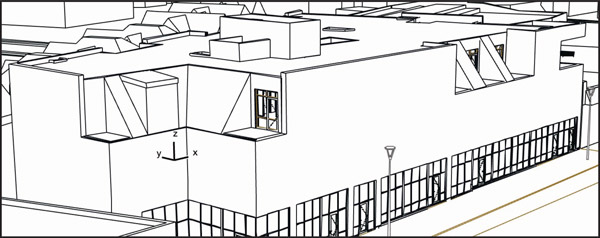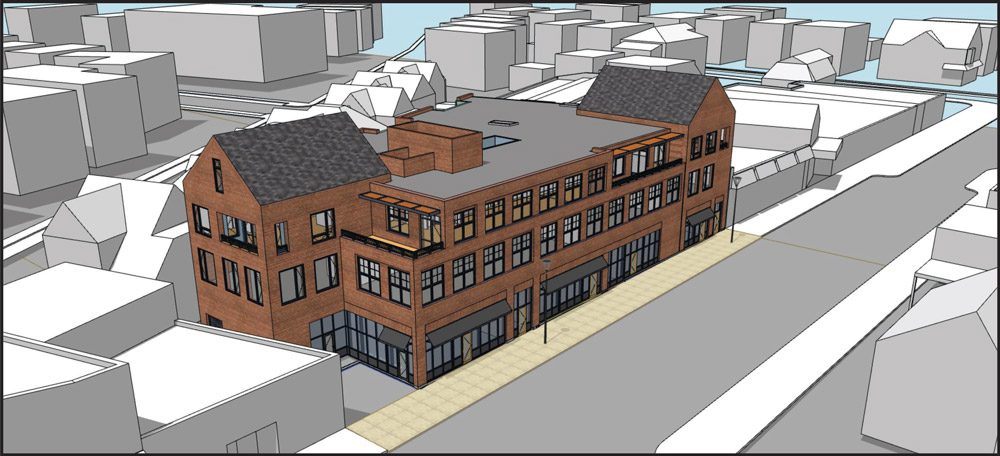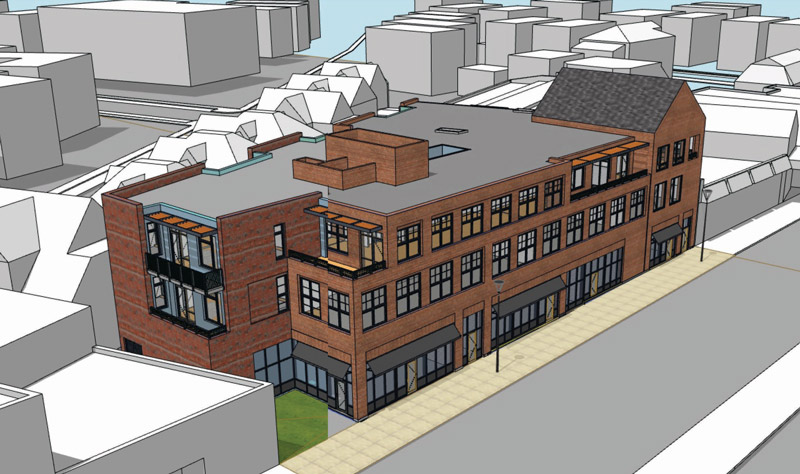We’ve developed three building design concepts to take to the next level of detail and exploration.
These are varied expressions of what the Remix can be, one more extroverted, another introverted, and a third that’s a combination. In this post, we’ll share how those designs emerged and our thoughts on what they offer.
In our previous Facade Variations post we shared three approaches to a multifaceted facade composition. The responses we got both from online comments and among our design team were diverse. Some people were drawn to the tall gable elements of the first scheme, and how they connected visually with the residential nature of the neighborhood. Others were more drawn to the varied second and third schemes, which broke the facade into three distinct elements. These distinctions made the building look more like a set of smaller buildings, and people were attracted to this scale breakdown.
Due to this mixed response, we decided to refine two concepts, one using the Iconic Gables and the other, a varied facade of smaller masses. From these two designs, a third, hybrid option was discovered by combining elements of both concepts.
Developing the Options
Refining the Gables design proved to be straightforward. The clarity and appeal of this massing concept was present in its first iteration in the Size and Style post. Bookending a central building block with the elevated gables generates both diversity in the mass and a cohesive quality to the composition. Gable roof forms have a powerful archetypical quality that the subconscious easily responds to. Refining this scheme simply meant reconciling the facade with the evolving floor plans and testing out window and balcony options. We call this design the Extrovert. See below for the latest modeling.
The varied facade was more challenging to bring into sharper focus. Although we value breaking the mass of the facade up into smaller elements, attempts at having multiple styles within the facade felt persistently busy, disjointed and contrived. Our attempts to compose the building as three differently stylized facades seemed contrived. In addition, when we tried to compose the massing in a unified manner by using dormers and sloping roofs on the third story, it felt awkward and forced.

When we instead carved into the mass of the facade using set-back balconies on the top story, the composition began to feel more natural; both unified and diverse. This direction provided distinctions across the facade without having to appear as multiple buildings. We liked this direction, referred to as the Introvert, and chose to refine it as an alternative to the Gables scheme.

Once we got to look at these concepts side-by-side, we decided to collage them together in a scheme that incorporated both styles. We were surprised to find how well this hybrid accomplished our design goals and we’re attracted to its composition. So we’ve included it here as a possibility.
–
Three Schemes
Here are schematic designs of the three concepts, and what we see as their respective strengths:
1. The Extrovert


The primary strength of this scheme is described above. The tall gables are “iconic”, in that they would be memorable and likely become a defining visual element of Westcott street. Though this wasn’t an intentional reference, the adjacent building to the north, housing Alto Cinco and the Westcott Theatre, has a similar composition with a long facade of the storefronts terminating at a taller gable-roofed structure at the theatre entrance. This design is extroverted by calling attention to itself and being unapologetic about the size and ambitions of this development. The downside to the Extrovert is that it is large in mass. While some people have encouraged us to push the acceptable limits of the building’s size, others will dislike the height of the gables and the shadow they will cast over the patio space.
2. The Introvert


This design may be simultaneously more unified and more varied than the Extrovert. Its strength is in subtraction, as opposed to the Extrovert’s additions, with the balcony set-backs driving the composition. The third-story setbacks help bring more daylight into the patio space. The simple horizontal, stepping roofline is resonant with traditional three-story main street development, such as the building just to the south, currently the home of Las Delicias. Although this design would still make a splash in the neighborhood, it will likely be more appealing to those who think this development should fit into the existing streetscape. In this way, this design is introverted, exerting a quieter, more subtle presence.
3. The Hybrid

The most varied composition of the three, the Hybrid includes a gable tower on the north end and the setback balconies on the south. Instead of the gable being a defining form in the whole composition, the gable becomes a solitary iconic element on one end of the facade. The patio gets the benefit of the setbacks, without them being the only roofline treatment. Though this scheme lacks the conceptual clarity of the others, it may be the right mix of elements that work for this scale and site.
Conclusion
For each of these concepts, developing it to the next level will require a lot of design work to get the facade right, composing the: windows, cornices, transitions, balconies, brickwork and public art elements. For those who read the post about the building’s circulation, it should be noted that in these schemes the elevator core is placed in the southern-central location and the second-floor commercial spaces found a home along the street side of the building.
–
As always, your feedback is important and welcome. Extrovert vs. Introvert or the Hybrid? What do you think?
READ MORE POSTS


Recent Comments